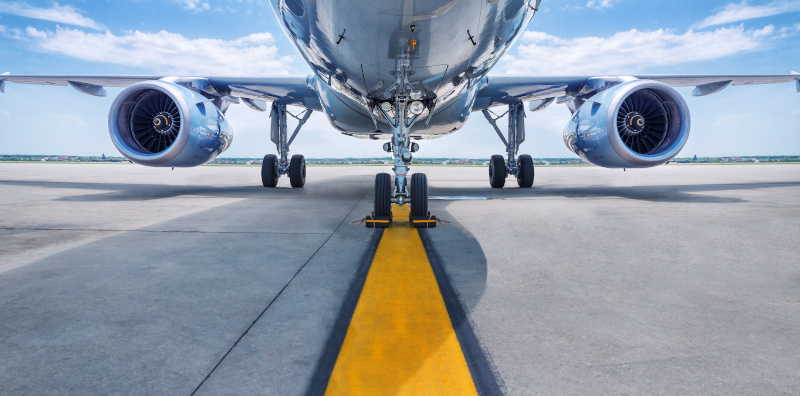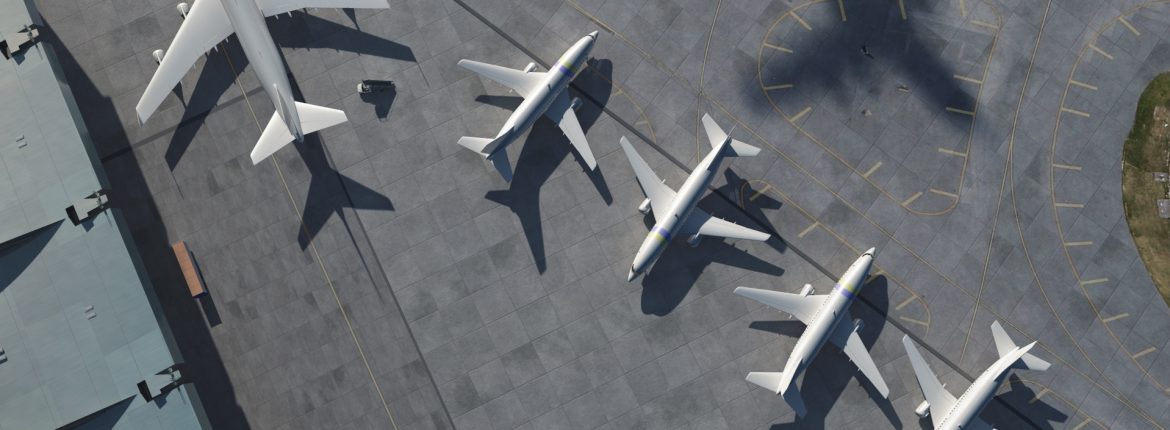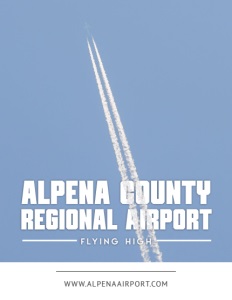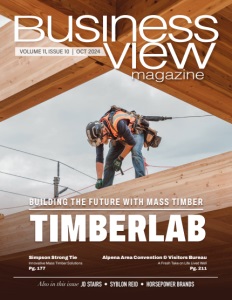Alpena County Regional Airport
Flying High
A Gateway to Attractions, Growth and Opportunity
Alpena County Regional Airport, situated in Michigan’s Lower Peninsula is more than just an airport—it’s a vital part of the local economy and a gateway to the natural and historical treasures of the area. Combining scheduled air service, military operations, and ongoing infrastructure development, the airport plays a pivotal role in the region.
Owned by Alpena County and licensed by the state, this Part 139 airport spans over 3,000 acres, boasting a 9,000-foot north/south runway and a 5,030-foot crosswind runway. It also hosts one of only four National Guard Combat Readiness Training Centers in the U.S.
A Hub of Connectivity
The airport’s role in the community is multifaceted. Delta Airlines, serviced by SkyWest, provides one to two commercial flights per day, complemented by daily cargo deliveries from UPS and FedEx. Huron Aviation Services operates a flight school on site, while also providing maintenance, and acting as a partner in operations. “It’s kind of a hybrid situation,” Airport Manager, Steve Smigelski, details.
“The county of Alpena does the fueling, but Huron Aviation takes care of all the other aspects, like meeting and greeting jets and coordinating ground transportation and the like.”
Alpena also accommodates a variety of military aircraft, due to its co-location with the Alpena Combat Readiness Training Center. “It acts as a military bare-bones base. So, all the essential equipment is already located in Alpena. All the unit has to do is bring its own people and its own specialized equipment. We see everything, Marine Corps helicopters, Navy helicopters. We even had F-35s here this year,” reports Smigelski. He notes that the facility regularly hosts high-profile military training events, including Operation Northern Strike, the largest air-to-ground exercise east of the Mississippi.
Reflecting on the airport’s resurgence coming out of the pandemic, Smigelski shares, “Generally things are much better now than they were that first year after covid. We average about 13,000 enplanements per year, and for the last two months, we’ve been doing better than 1200 a month.”
Embracing Change and Innovation
One of the most notable upgrades at Alpena Airport is the construction of a new passenger terminal, completed three years ago. “The old passenger terminal was the flower of 1950s technology, which is to say it was quite hideous,” Smigelski quips. “There wasn’t even a passenger boarding bridge. There was a boarding ramp that would get pushed up to the aircraft, and if it was raining or snowing you got treated to the rain and snow as you were queuing up to go inside the airplane.” This modern facility brings a welcome host of improvements including an ADA-compliant design, a passenger boarding bridge, and expanded ramp space capable of handling larger aircraft like the Boeing 767.
The terminal’s upgrades extend to security, with the Transportation Security Administration (TSA) introducing additional features to improve the travel experience. “TSA has really been working fantastically well with us. We weren’t scheduled to receive one of those 360-degree scanners, but they put one of those in when the terminal was completed,” explains Smigelski.
“We also received a full baggage X-ray system. So, the TSA agents don’t have to check by hand everybody’s bag that comes through. Now they just run it through the X-ray machine. So that’s put a little bit more personal space back into travel, and it’s also expedited the boarding process.”

Award Winning Challenges
A major project to rebuild the airport’s main runway faced unexpected complications, which were swiftly addressed thanks to the quick thinking of Alpena’s engineering and construction teams. The runway construction involved eight inches of concrete, followed by three inches of asphalt, a bond breaker, and another 20 inches of concrete underneath.
The plan was to strip off the top layer of concrete, regrind it, and use it as gravel for the remainder of the project. Smigelski recounts, “When they did that, there was a significant amount of weight that was basically lifted off of the substrate. We came into work the next morning, and the main intersection between runway 7/25 and 1/19 had heaved up or basically blown out.”
On the fly, a plan was devised to completely rebuild the intersection. Smigelski notes that this involved extensive coordination between the FAA, the contractors, and the engineering firm. “RS&H is our engineering firm, and they did a great job of coming up with an engineering solution in just a matter of days,” he conveys.
“Our contractors that were doing the work, M &M Excavating and Pyramid Paving, they just rolled with the punches. It was like it was part of the plan. It added three more weeks to the project, but it got done without any hitches.” Smigelski highlights that the handling of this situation played a key role in Alpena Airport receiving both the Award of Excellence for Apron Rehabilitation and Runway from the Michigan Concrete Association and the Airport of the Year award from the Michigan Department of Transportation Office of Aeronautics.
Funded by CARES Act money, this setback added $2 million to the project’s costs, but the airport did not have any additional CARES funds available. In response, the FAA quickly assembled an AIP grant to cover the necessary repairs to the intersection. Emphasizing the importance of the runway project for both civilian and military operations, Smigelski details, “The military requires reinforced touchdown zones because when they bring in a C-17 or a C-5, it can touch down on the pavement at 900,000 pounds.” He describes an additional investment from the National Guard Bureau for the military portion of the construction, which involved starting at the dirt layer and rebuilding with reinforced concrete, followed by the installation of aircraft arresting systems. “Our piece, even with the intersection failure, was about $15 million. Their portion of the project is topping $50 million. So, there’s been a significant amount of money put into the runway,” he says.
Future Plans
With $4 million allocated from the Bipartisan Infrastructure Law (BIL), the airport plans to construct 20 new nested T-hangars. Noting the demand, Smigelski says, “We didn’t even advertise that we were going to be putting in new hangars, and we already had 30 letters of intent for 20 hangars.”
The potential for a new box hangar to serve as both a cargo facility and a transient aircraft space is also on the horizon. “Right now, FedEx and UPS land their aircraft, and they basically unload the aircraft right on the ramp. So, if it’s raining or snowing, your package from Amazon might get some water spots on it,” Smigelski acknowledges.
“We’ve got plans to use what is left of the BIL money and put in as big a box hangar as we can. That could serve as a cargo handling facility. It would also be good for transient aircraft. And we take a large number of medical evacuations every year.”
The airport’s efforts to attract new businesses to the surrounding area are part of Alpena County’s economic development strategy. “We have a bunch of undeveloped property on the west side of Airport Road, and we’re in the process right now of having all the trees clear cut off of it,” he expands.
“The county is going to invest a significant amount of money by putting in water and sewer lines, so any potential businesses won’t have to worry about those utilities. They’ll already be in place.” He relays that a collaboration between the airport, economic development agency, Target Alpena, and the county, has resulted in attracting a recycling center, which will be located in the south end of the available property.
Enhancing Local Tourism and Economy
Alpena’s charm extends beyond the airport, with the region boasting a wealth of attractions. As a former port town in the 1800’s, the community celebrates its maritime heritage, from shipwrecks and glass bottom boat tours to lighthouses. The National Ocean Atmospheric Association (NOAA) has even established a freshwater marine sanctuary in Alpena, drawing large numbers of visitors. The downtown district, once struggling, has seen a vibrant revival, with increased tourism driven by new cruise ship visits and local events.
We work very closely with the Chamber of Commerce and Target Alpena,” Smigelski remarks.
“We’re the first glimpse that people get of Alpena when they fly in. We try to be as business-friendly and forward-thinking as we can.”
As Alpena County Regional Airport continues to grow and evolve, its ongoing contributions to transportation, military operations, and economic development highlight its vital role in enhancing the region’s growth and connectivity.
AT A GLANCE
Alpena County Regional Airport
What: A Part 139 Airport spanning 3000 acres
Where: Alpena County, Michigan
Website: www.alpenaairport.com
PREFERRED VENDORS
Alpena Area Convention & Visitors Bureau – VisitAlpena.com
A Fresh Take on Life Lived Well – Alpena, MI: Sanctuary of the Great Lakes
A charming small town at nature’s doorstep
Nestled between a lush green forest and a vast blue bay, Michigan’s Alpena Region is miles away from the weight of the world. Alpena, a community founded on the fishing and timber industries, is now the place where history and heritage meld with relaxed outdoor adventure on the shores of Lake Huron.
Alpena is known as the Sanctuary of the Great Lakes for its pristine natural landscape and insulation from the hectic life stress endemic to metro areas. To-do lists fade away with the rising sun in this charming small town.
The Alpena Region boasts more than 100 miles of groomed trails for hiking, biking, and nature watching. More than 300,000 acres of open water; 1,000 miles of shoreline; 7 lighthouses including the tallest and oldest accessible lighthouses on the Great Lakes; more than 50 parks; and 43,000 acres of State Forest land offer endless opportunities for sailing, fishing, exploring, swimming, birding, and easing into the sounds of wind through the pines and waves meeting the shore. Tour the 18.5 mile accessible Bi-Path, winding through forests, along miles of Thunder Bay River, through quaint neighborhoods, past public art installations, and through the vibrant downtown district, with galleries, boutique shopping, farm-to-table food, microbrew, hard cider, ice cream and locally-vinted wine. Kayak at the 500-acre Alpena Wildlife Sanctuary and lazily float around the reeds viewing painted turtles, otters, swans and Great Blue Heron.
Alpena is headquarters to Thunder Bay National Marine Sanctuary, an underwater park protecting more than 100 shipwrecks in northwestern Lake Huron. Learn more at the Great Lakes Maritime Heritage Center, or aboard Lady Michigan, Alpena Shipwreck Tours’ glass-bottom boat.
“The adventure continues after dark as Alpena is centrally located to 3 Dark Sky Preserve Parks. Light pollution is extremely low, bringing into focus the stars, planets, moon, and Milky Way in pure grandeur,” said Mary Beth Kline-Stutzman, President & CEO of the Alpena Area Convention & Visitors Bureau.
Whether you’re enjoying Alpena’s premier fishing or watching a concert in the park, the surrounding natural beauty breathes life back into your smile. In Alpena you are reminded about what matters most in life – time spent with people you care about. You are invited to escape the stress of life and relax, restore, and rejuvenate in Alpena, Michigan; a fresh take on life lived well. Get inspired at Visitalpena.com.



